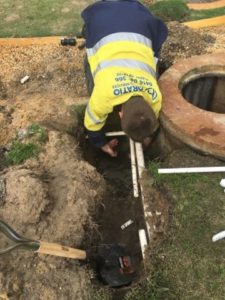Sewer Pump Pits
In a residential situation, pump pits are used to pump waste, sewerage or storm water to a higher level, to allow it to drain with gravity to the sewer/storm water drains. If you are extending, renovating or converting a shed/garage into a bathroom/kitchen, you may require a small pump pit to carry the liquid waste to a permitted discharge point. Usually pump pits are buried underground, which allows for the right size chamber/liquid storage. However today you are able to get small macerating pumps that are installed above ground, perfect for small bathroom renovations, small sinks/prep area’s. It allows the installation of plumbing fixture’s in places that gravity wouldn’t usually allow, it’s also perfect for other types of installations where cutting concrete isn’t able to be carried out.
In commercial/industrial situations, pump pits are used frequently and in all sorts of area’s, some large sites may require multiple pump pits to allow waste to be transported to a higher level, so gravity can take the waste away again, allowing sewers to stay reasonably shallow, compared to a gravity setup from start to finish. Pump pits are also used in grease waste installations, to allow grease traps to be installed and connected to main sewer. In high rise buildings pump pits are frequently installed in the basement to pump sewerage and storm-water to a higher level to allow it to be discharged into the main sewer/storm-water connections.
Maintenance

Burst line from a pumped Septic Tank
Depending on the type of system installed, scheduled maintenance must be carried out to the manufactures requirements, this it to ensure the correct operation of the pump, valves and system as a failure of a pump pit can be quite serious. However, often pump pits are not routinely maintained, which causes premature failure of the pump.
Sometimes the pump lines can burst, which causes frequent bubble ups of effluent or storm-water in certain locations, and if the pump lines are inside a builder, can also cause quite a mess.
Installation
Depending on the type of installation, installing a new pump pit can be completed in about eight hours. First the correct pump chamber size must be chosen, after that the correct pumps and pipe sizing must be selected. It’s also important to work out the working heights inside the tank, including the inverts for sewer entry. Pipes will also have to be taken from the pump pit for a vent, and conduits for electrical connections. Depending on the purpose of the pump pit, a control box might be installed adjacent to the pit with or without an alarm. Isolation and non return valves will be installed inside the pit and then the pressure line will be connected to the sewer or storm-water connection.
Horatio Plumbing Services are able to replace broken pumps, overhaul pump sets provide temporary pumps to keep services operational.
